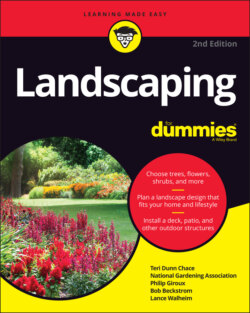Читать книгу Landscaping For Dummies - Lance Walheim - Страница 104
Stacked-stone retaining wall
ОглавлениеA stacked-stone retaining wall should have a backward slant (batter) of 2 to 3 inches (5 to 7.6 cm) for dry-set stones and 1 to 2 inches (2.5 to 5 cm) for mortared stones. This slant helps your wall counteract gravity. If you prefer to use mortar, see Chapter 5 for full details.
Building a 2- or 3-foot (.6 to .9 m) high wall of dry-stacked (no mortar) stones requires considerable lifting and adjusting of stones, but it’s enjoyable work if you aren’t in a hurry. It pays off with a handsome wall. Follow these steps, and consult Figure 4-4:
1 Dig into the hill, about 15 to 18 inches (38.1 to 45.7 cm).
2 Dig an ample base.We recommend a trench 2 feet (.6 m) deep and wide enough for the broadest stones plus a 4-inch (10.1 cm) drainpipe.
3 Place gravel in the trench and compact it, 4 inches (10.1 cm) deep.Lay the drainpipe along the back corner, sloping it toward the outlet end. Then add another 12 inches (30.5 cm) of stones to the trench.
4 Using the largest stones, set the first course in place.Tilt the stones back slightly, toward the bank. Check frequently that the top of the wall is level. When it isn’t level, make adjustments.
5 Drape landscape or geotextile fabric against the inside back wall, and backfill with gravel or drain rock as you lay each course.
6 Build up the wall with stones.As you lay each course, lean the wall into the hill at a rate of 2 to 3 inches per foot (5 to 7.6 cm per .3 m) of wall height. A 3-foot (.9 m) wall, for example, must lean 6 to 9 inches (15.2 to 22.8 cm) into the hill.
7 Within 12 inches (30.5 cm) of the top of the wall, fold the filter fabric over the stones and backfill the rest of the wall with topsoil.If you want, install a capstone.
© John Wiley & Sons, Inc.
FIGURE 4-4: Building a stacked concrete or stone wall, without mortar, requires careful placement of the stones.
